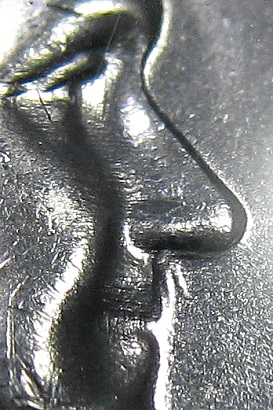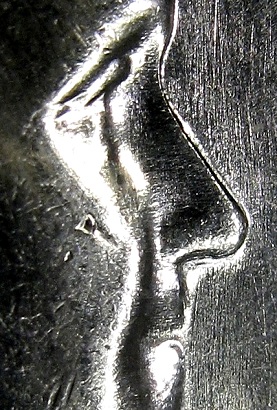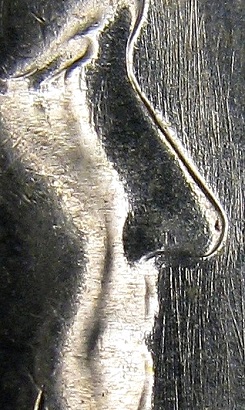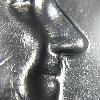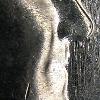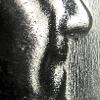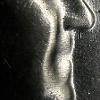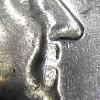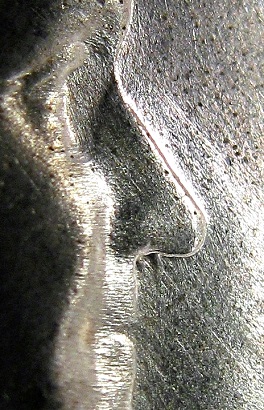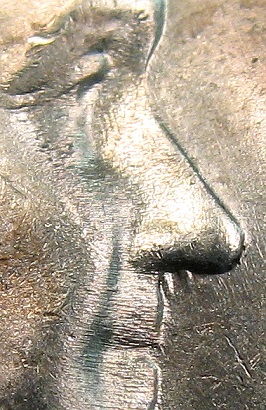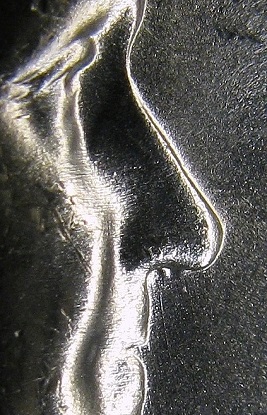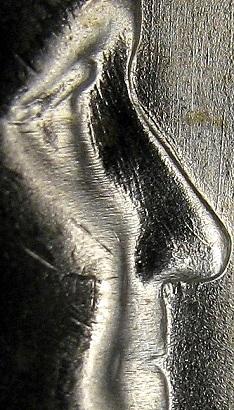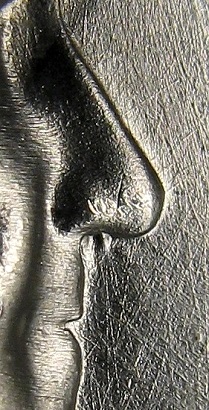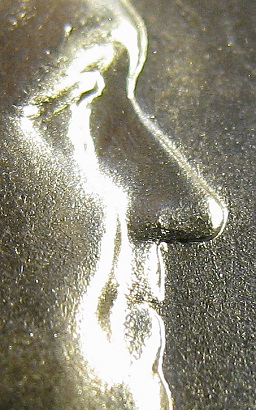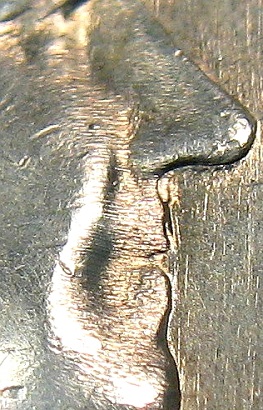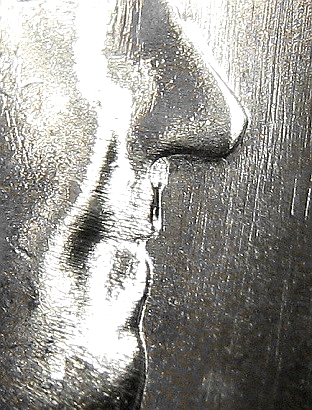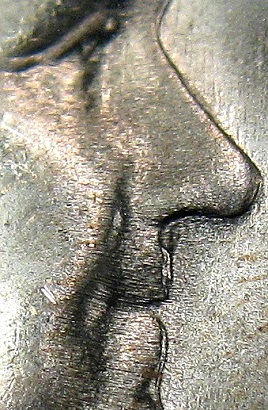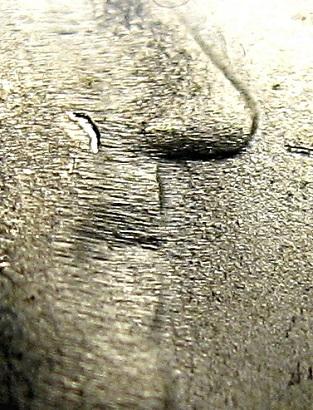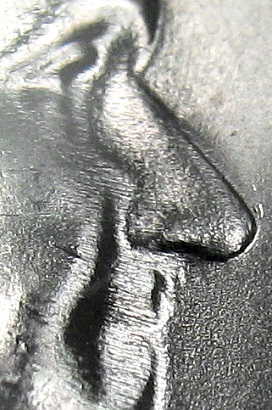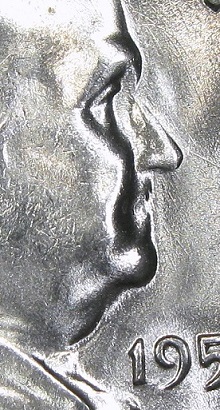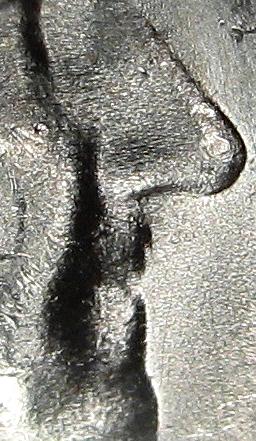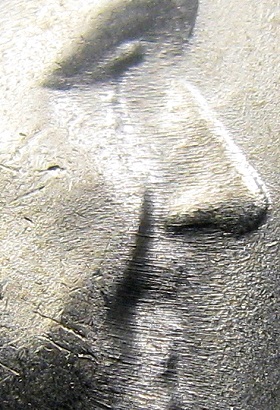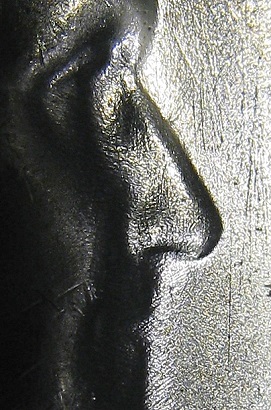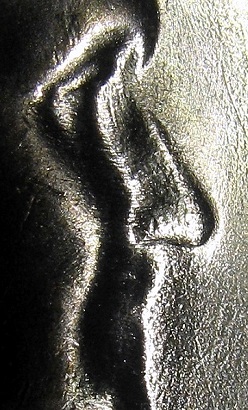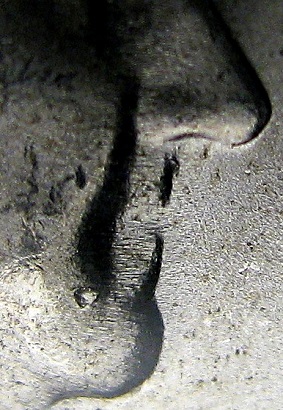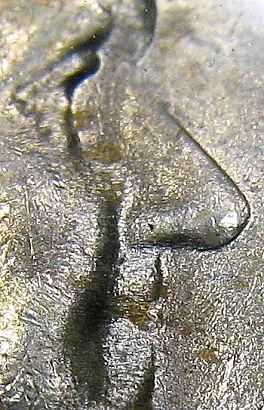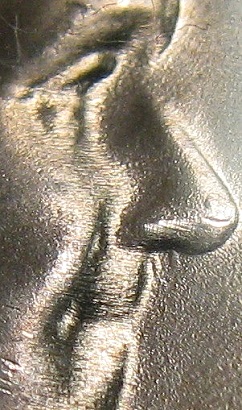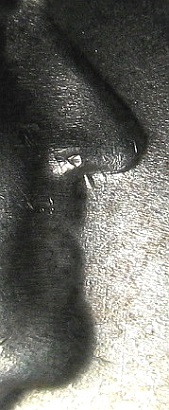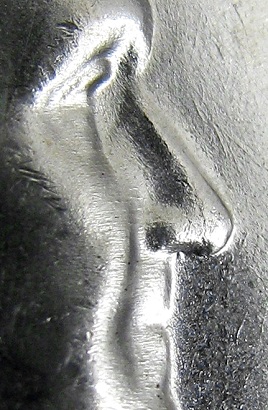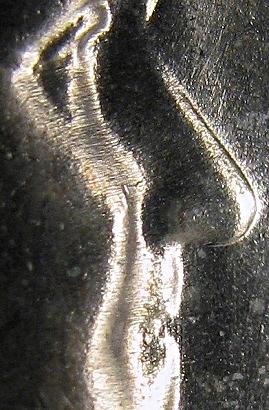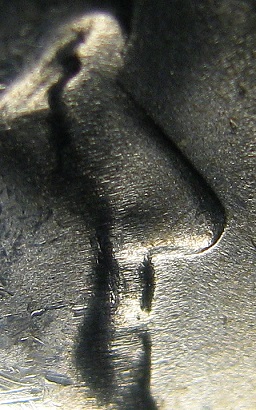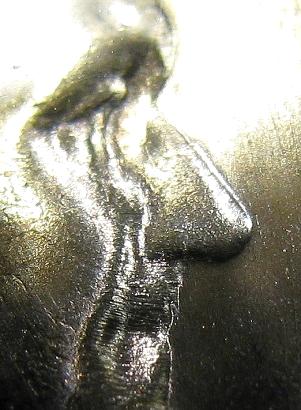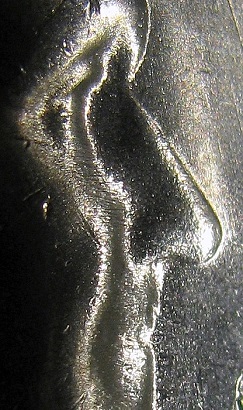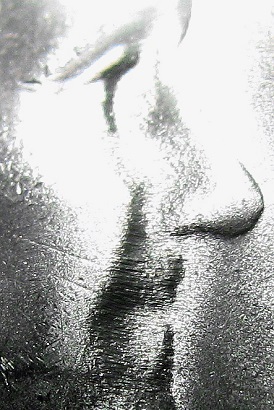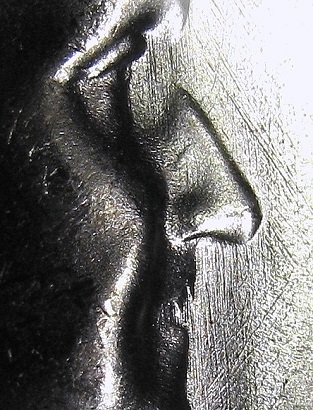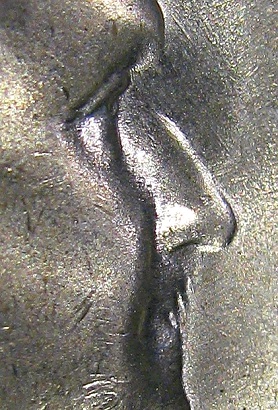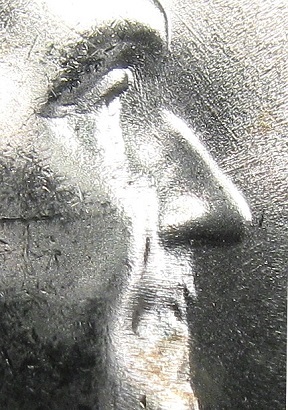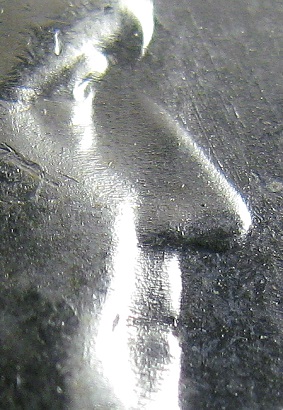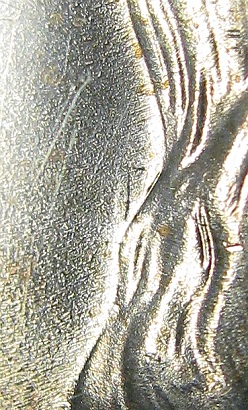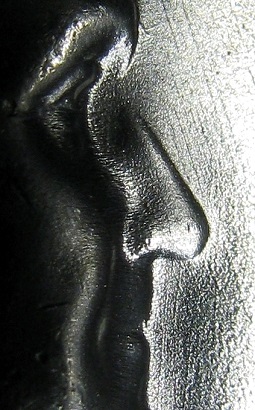Franklin Variety Index
Bugs Bunny Die Clashes 1953-1955
1953 FVI Bugs Bunny A-1
Wing clashing runs from inside mouth, across the lip, and into the field, with several clash lines showing inside slightly open mouth, and three strong spikes found within a rounded depression in front of mouth. A pronounced horizontal line under nose marks the top of the field depression. Slight collar clash. Strong bulge under eagle. Thin cap on bell shoulder. Usually found somewhat glossy, and with heavy, parallel die scratches all over the left obverse field, especially around the letters and devices. A die scratch rising from the second stand of N is visible to some degreeon all stages of this die.
1953 FVI Bugs Bunny A-1a
Only the strongest clash in front of the lip and the horizontal line atop the depression still show, but are weakened, as this stage was struck immediately following a harsh refinishing of the dies. Clashing inside mouth weakened.These coins are extremely glossy and reflective over both sides. Extensive, new filing lines run up and down around the mouth and profile, in addition to those already present on the left obverse. This stage is short lived and rare; only those that show fresh polishing and borderline PL fields will qualify.
1953 FVI Bugs Bunny A-1b
The mirrors have faded, the die lines have swelled and become more prominent, and clashing inside mouth is gone. The remaining die clash on lip is starting to fade and may become weak, but the horizontal line under nose is clear. Only those that still show a clearly discernible lip clash spike, qualify for B-1b.
1953 FVI Bugs Bunny A-1c
A diminished stage of the variety, but prevalent enough to require a separate number for differentiation. The lip clash is no longer visible, in fact the lip may be stretched from star bursting die erosion. Only the horizontal clash line below the nose survives the extreme die erosion of this frosted, late die state. Meandering die crack develops through lower left bell lines.
The withered, vertical polishing lines that now appear to float under nose are often mistaken for clashing. The following die progression study demonstrates that the two lines that remain under nose in stage "c" are not die clashing, but rather, actively eroding remnants of die polishing.
Click to compare six stages of this die marriage
1953-D FVI Bugs Bunny C-1
Two bold, cylindrical clash lines protrude from nose. Lip drawn and spiked at the tip, from clashing. Noticeable collar clash. Numerous, long die polishing lines in canvas pattern over each side are resulting from complete refinishing, lending a bright, satiny sparkle to the luster of this scarce, early stage.
1953-D FVI Bugs Bunny C-1a
The strongest of the 1953-D Bugs Bunny clashes; the two nose clashes have become even more noticeable as the die lines fade, and parts of the upper lip are more obviously spiked. Collar clash still clear. Two reverse die lines have become diagnostic; one connecting the P in PLURIBUS to the left bell pole, and another running directly through the A in AMERICA and down into the field below. Most other lines faded away as the dies deteriorate, but these get stronger until the end stages.
1953-D FVI Bugs Bunny C-2
At least two, and usually three, moderate spikes protrude from the nose, and two tiny, delicate spikes show at the opening of mouth on earlier stages. A thin die line runs from nose down below mouth. Other scattered die lines in field near chin, mouth, and nose area, all running on a southeast slant. Damage to right side of bell wall. Mint mark below level of bell bolts, right of center, and thicker at base, probably due to slight re-punching.
1953-D FVI Bugs Bunny D-2
Another very strong variety.Two plump, cylindrical spikes protrude from nose. The longer, flatter spike at left, the more plump but shorter spike centered. This is a very strong nose clash, similar in strength to C-1a, but there is no clashing on lip. Numerous crisscrossing die lines surround profile. Faint nose crease, high. Small collar clash. Noticeable damage to right bell wall, short protruding spike cut off by numerous die lines in field. Mint mark below level of bell bolts and double punched, with extra heavy lower half and split serifs.
1953-D FVI Bugs Bunny D-4
A single, very bold, cylindrical clash mark drops from nose, left of center. The only 53-D die with a single, distinct line under nose. The mouth is open and the upper lip slightly distorted, but no discernible clashing inside. Crease high on nose, and large part of nose in front of eye polished away, similar to C-1. Collar clash on neck and very thin, long goiter under chin. One defiant die line curves upwards from near the tip of the nose , while surrounding lines run parallel to nose. Sharp triangular spike on right side of bell, with more damage above that, and signs of re-engraving there.
1953-D FVI Bugs Bunny D-5
Two clash marks drop from nose; a short spike from corner and a delicate spike or ripple from center. Both lines can disappear at some angles due to an optical allusion (see pictures), so careful scrutiny is needed to see the clash. Crease high on nose. The main attraction of this die pair is a strong collar clash, which stretches up the neck and turns into a nice goiter under chin. A faint ripple in field left of the 1 represents a trace of a horn clash. Damaged right bell wall, above the level of the bell lines, with signs of re-engraving at and below the level of the bell lines.
An interesting clash and one of the most common 1953-D clash varieties.
1953-S FVI Bugs Bunny A-1
This early stage shows multiple, delicate spikes across the upper lip; one just inside the mouth, one parallel to the upper lip, and one fainter spike jutting out from the lip at about 45 degrees. Additionally, several arches, running along bottom of nose, were created by the wingtips. The bridge of the nose is noticeably re-engraved where a spike would have jutted into the field. Faint collar clash and very nice goiter clash under chin. Meandering die line from top corner of D to bell lines is diagnostic. Surfaces generally crisp and satiny from fresh polishing. The mint mark is completely filled, and the clapper is often weakly struck on this die pair, possibly from die damage caused by the clashing.
1953-S FVI Bugs Bunny A-1a
The delicate spike at 45 degrees no longer shows, with just a nub where it once crossed the clash line running down lip. The clash inside mouth may be indistinct. Goiter clash still visible, but surfaces are becoming more frosty and features will begin to warp. The die line connecting clapper to bell lines may be broken or indistinct.
This middle stage is the most frequently encountered.
1953-S FVI Bugs Bunny A-1b
In this diminished stage, the lip spike has shortened and largely merged with the lip, leaving only a bulge near lip and a trace of the wingtip arches. The dies have become very grainy from erosion.
1953-S FVI Bugs Bunny D-1
One noticeable, cylindrical spike drops from center of nose. Light collar clash and faint horn clash in field. Slight trace of letters behind head, rising up from hair. Slight bulge under eagle, cap on bell shoulder, and severe damage to right bell, at bell lines, which has been harshly filed, leaving jagged spikes.
Most examples seen are very late die states, with diminished features from star bursting.
1954 FVI Bugs Bunny A-1
Several bold feather clash lines fan out from upper lip into field. The first spike actually overlaps the lip. Spike jutting upward from bridge of nose. Large horn clash is extra heavy on its upper side as it curves along neck. Sharp, long, vertical die scratch grazes back of head and is diagnostic. Sharp nose clash juts out from right bell, well above bell lines. Delicate die line from top of A in DOLLAR to eagle's perch shows on the earliest stages, but disappears before the A stage.
1954 FVI Bugs Bunny A-1a
A diminished stage. Die erosion has left two fuzzy clash lines between lip and nose, and weak or indistinct clash on lip. Spike on nose, die line grazing head, and nose clash from right side of bell all weak, but visible. Die line from A to perch no longer shows.
1954 FVI Bugs Bunny A-1b
A terminal die state made interesting by die chips. Star bursting and other die wear has nearly obliterated the Bugs Bunny clash, but some will still show faint clashing in the field. Die wear and the die line behind head make skull appear to be splitting open. Nose clash above bell lines still faintly visible. The development of a meandering die break, containing tiny die chips, connecting the eagle's left-facing with to the bell, makes this end-stage of renewed interest. Only examples that still show some clashing under nose will qualify for A-1b.
1954 FVI Bugs Bunny A-2
Sharp clash, positioned further left and more over mouth than A-1, forks upper lip, with just 1 bold clash jutting into field. Slight crease through center of nose. Bold horn clash abruptly curves upward to form slight goiter under chin. Numerous, bold die lines around mouth, and one short die scratch moving northwest from top of 9, which shows on all stages. Nose clash damages right side of bell, right at the upper bell lines. Very heavy cap on right bell shoulder. Strong bulge under eagle. Several bold die lines on reverse, with the strongest two being one connecting RI of PLURIBUS to left bell hanger, and another connecting the lower right corner of bell to eagle's tail feathers.
1954 FVI Bugs Bunny A-2a
1954 FVI Bugs Bunny A-2b
A diminished stage. Star bursting striations have erased all but a faint spike on lip. Horn clash weaker but still clear, and is often the diagnostic factor, along with the spike through 9 .
1954 FVI Bugs Bunny A-3
The mouth is bisected by a series of spikes, both inside the open mouth and in front of lip. The most obvious clash lines are two parallel spikes, one from upper lip, the other in the open field. Reminiscent of 1948 B-1, except that here there is also mouth clashing here. Always found in extremely advanced die states, which can make attribution challenging. Importantly, only a heavy collar clash is seen on this die marriage, no horn in field, as seen on other 1954-P varieties. Light spike jutting into field from center of nose. Traces of letters behind head are merged with hair and polished out of the field. Heavy die lines in fields, with a notably long, bold line running across the grain of the others, from above IN toward the gap between LIB and head. Very small bulge under eagle and only slight damage to right bell wall at upper bell lines, with no apparent nose clash under eagle. Medium sized cap on bell shoulder. Meandering die crack through lower left bell lines on all seen. Die break with tiny chips vertically down eagles chest.
The advanced die state of all seen may indicate that the clashing took place late in the life of the die. If an earlier stage exists, we would love to see it!
1954 FVI Bugs Bunny A-3a
The most commonly found stage. As the teeth outside mouth begin to erode and become fuzzy, the upper lip actually seems more forked, at some angles. However, this is a diminished stage of the variety and of considerably less visual appeal.
1954-D FVI Bugs Bunny A-1
The wing has clashed directly over an open mouth, and low, with three spikes; one faintly inside mouth, one large triangular spike jutting down from upper lip, and one faintly angling out of upper lip. The center spike is very bold, detached form lip, and drops below the lower lip! No visible crease on nose, but damage in front of eye has been tooled. No discernible collar clash, but wide horn clash in field. Long, faint spike from right bell wall and tiny hair outline through EPU is the only reverse clashing. Distinctive, unusually crisp D mint mark is centered, level with bell bolts, and noticeably re-punched, with nicely split lower serif. Diagnostic, die scratches include a horizontal line above and left of mint mark, and a vertical line connecting the bell bolt at right of D to the S above.
A rare and outstanding 1954-D variety.
1954-D FVI Bugs Bunny A-1a
Polishing and die erosion has left only faint evidence of the 3 spikes, in the form of a somewhat jagged upper lip. The once-bold central spike is virtually invisible. The open mouth shows a few die lines inside, which can be confused with clashing. The repair work on nose is faded.Reverse remains similar, but D mint mark is now coarse and partly filled at bottom, like most other 1954-D dies. RPM still shows clearly on lower serif, as do diagnostic die scratches nearby.
The more common and much less dramatic stage of this variety.
1954-D FVI Bugs Bunny C-1
Two long, cylindrical spikes angling down from nose, traces of more along lip, and a mixture of die clashing and die polishing inside open mouth. Bold crease high on nose, also creating a spike running up into the field. Collar clash on neck. Three die scratches are diagnostic across all stages; a curved die line on lower half of nose; a short, straight scratch on neck, just above collar clash; and a long, straight, diagonal scratch across Franklin's shoulder. Interestingly, there are two widely separated nose clashes jutting from damaged and lightly re-engraved bell wall, one at bell lines, one well above. Mint mark above level of bell bolts. A serious die clash. Typically found with gleaming surfaces from fresh die polishing.
1954-D FVI Bugs Bunny C-1a
In this diminished later stage, only short nubs remain under nose, and clashing still show inside mouth, though frosting has merged many of those features. Nose crease still clear, but spike in field diminished. Collar clash still strong, and slight new goiter clash now apparent under chin. Three diagnostic die lines all visible. While clashing has begun to fade, various die lines that were once fine polishing lines have now become more pronounced, including various lines on Franklin's nose, lines in the field near profile, and the re-engraving lines on right bell wall. The once gleaming surfaces are now frosty.
1954-D FVI Bugs Bunny C-2
Two spikes from nose, similar to C-1, but not quite as bold. Also shows mild clashing inside mouth. Heavy filing lines under nose, which grow even courser as the obverse die wears on. Interestingly, there are actually two faint creases on nose; indicating multiple clashes; the lower of which also spikes into the field. Light collar clash on neck, with faint trace of a horn clash in field. Letters behind head. A die crack on edge of shoulder starts above JRS and shifts to a second, lower crack, before finally traveling up toward the chest. Long, faint nose clash jutting from bell wall. Numerous fine polishing lines, and gleaming surfaces, in early stages. Mint mark just right of center and falls just below level of bell bolts.
1954-D FVI Bugs Bunny C-3
One heavy spike coming directly from the corner between lip and nose compliments several lumps inside open mouth. Crease high on nose. Large collar clash extends out into field but is often fuzzy around the edges. Damage to right side of bell, with nose spike just above bell lines. Small cap on bell shoulder. Mint mark centered, cocked left, and above level of bolts. Both sides display extensive polishing lines in fields, with a particularly dense patch patch above "OD WE."
Need a speciment for photography!
1954-D FVI Bugs Bunny D-1
Another very strong 1954-D clash. Two large, cylindrical spikes are reminiscent of 1953-D FVI Bugs Bunny C-1a, but the lip and mouth are not affected. Crease on nose, above center. Letters behind head. Collar clash on neck. Parallel, horizontal die scratches in field below chin on all seen. Nose spike just above bell lines. Faint cap on bell. Mint mark just above bolts.
1954-D FVI Bugs Bunny D-2
Two clash lines drops from nose, the strongest at left. The right clash sometimes faint. Slightly open mouth seems unaffected. No readily visible nose crease. Slight collar clash. Two long, parallel, vertical die lines in front of chin visible on all seen. Heavy die filing lines under eagle to remove nose clash. Similar filing lines follow a hair line clash through EPU. Mint mark centered and falls just bellow level of bolts.
1954-D FVI Bugs Bunny D-3
One clear, cylindrical clash line drops from left half of nose, and a trace of another sometimes shows in the corner. Mouth slightly open but no discernible clashing inside.Heavy crease on nose lines up with eye socket. Large collar clash follows curve of neck up under the chin into a slight goiter. Numerous long die scratches on each side. Some stages show two heavy, long, parallel die lines from tip of nose almost to top of 9. Large area of damage to right side of bell, above bell lines. Mint mark well-clear of bolts.
1954-D FVI Bugs Bunny E-1
Several noticeable clash lumps inside slightly open mouth. The first true Position E documented in the series. Slight collar clash on neck. Small bulge under eagle, damage to right bell wall, above bell lines. A horizontal die line inside the right bell loop, as well as a series of three or more heavy die scratches running horizontally from the right bell pole, are diagnostic. Mint mark above bolts, and seems to be rather crisply punched for this date.
1954-D FVI Bugs Bunny E-2
Several noticeable spikes inside upper lip inside a slightly open mouth. There was some debate on whether this might be a C position clash, due to what might be a very faint clash line under the nose. Because our analysis of that nearly imperceptible line has been inconclusive, we are comfortable categorizing this as an E position clash. Crease high on nose. Minimal evidence of clashing elsewhere. Bottom of Mint mark even with bell bolts.
1954-S FVI Bugs Bunny A-1
The upper lip is boldly forked into three spikes, the uppermost one very delicate. The center spike is so sharp that it looks like a razor blade. Collar clash on neck and and thin goiter clash under chin. Evidence of a spike rising from center of nose into field has been polished down to a tiny nub. Round bulge under eagle, slight damage to bell wall, and strong cap on bell shoulder. Thin serifs on mint mark, which is just left of center. Also a minor RPM west. Upper loop filed by die chip. The dies were freshly filed and polished, leaving gleaming, semi-reflective surfaces and numerous, fine die lines over each side. This A-1 prime stage is reserved exclusively for examples that show all 3 spikes and semi-reflective surfaces. Rare.
1954-S FVI Bugs Bunny A-1a
The dies are now satiny to frosty, and only the bottom two clash spikes are required to show clearly, though some will faintly display all three. The once numerous die lines expand and shorten over time, and some have already vanished. Later stages will start to show jaggedness on the lip spikes, as shown in the supplemental pictures, but the bottom two spikes are clearly delineated.
1954-S FVI Bugs Bunny A-1b
A greatly diminished stage of the variety. Heavy orange peal textured star bursting frost has engulfed each side, erasing virtually all die lines and leaving very weak definition to the spikes, which are no more than a bulge on the lip, at this point. The collar and goiter have merged with neck. Bulge under eagle and cap on bell still show clearly, despite heavy die erosion.
1954-S FVI Bugs Bunny C-1
A minor Bugs Bunny variety, but one that shows extensive and interesting clashing elsewhere. Two faint nubs show just under the edge of the nose, the upper lip is distorted, and a clash spiked shows inside the open mouth. Spike from nose polished off like on 1954-S FVI. Bugs Bunny A-1. Other similarities are the collar clash on neck, goiter under chin, and damage to the back of Franklin's head, where letters were likely clashed and filed off. The positions and die lines are different, so these are different dies. Parallel filing lines along bridge of nose and vertically, under nose. Slight damage to bell wall, just above bell lines. Cap on bell shoulder. Both loops of the normal, thick, centered S mint mark filled by die chips. An earlier stage may exist with sharper Bugs Bunny features under nose.
1955 FVI Bugs Bunny A-1
An extreme clash forks the upper lip into two, razor blade, fang-like spikes. Both spikes are affected by extreme die filing, leaving patches of fresh, parallel die scratches all over the obverse and reverse, especially around the profile, bust, and bell. Eye socket polished away. Collar clash on neck and small goiter clash under chin. Among the numerous die scratches, one particularly bold, long die scratch curves up behind head from the O in GOD, through the lowest curl, and ending in the field next to the second curl. Strong rectangular bulge under eagle, medium cap on bell shoulder.
1955 FVI Bugs Bunny A-1a
The dies clashed again; now three distinct spikes can be counted across the upper lip, and the original two have been strengthened. This is the most dramatic of the three major stages of this die pair. The die polishing ranges from quite bold to fading away. The surfaces range from somewhat glossy in the earlier stages, to a delicate satin, and then to heavy frost, as the die erodes.
1955 FVI Bugs Bunny A-1b
The upper spike has now vanished due to die erosion. Most of the once sparkling die lines have faded as well, and there is now a faint, zigzagging die crack on edge of the shoulder, to the right of JRS. The long die scratch from O to curl is broken and indistinct in places. Die wear almost erases any trace of the light goiter clash, though the collar clash typically still shows. Thick frosty or even orange peal textured luster has enveloped over each side, making for some extremely beautiful, high-grade coins. The most common stage.
1955 FVI Bugs Bunny (Provisional Entry)
Unclassified position. The upper lip has been filed and polished away, concealing what appears to be clashing inside the mouth, on the lip, and potentially beneath the nose. Long, very heavy, parallel filing lines in front of mouth, one line running from nose to chin. Collar clash and light horn clash in field. Just a small, rounded bulge under eagle, and thin cap on bell shoulder. Found in extremely late die states, with eroded features. An earlier stage must exist, but has not been verified. This is not a late die state of A-1, because there is no die crack on shoulder, nor can any other features be matched up.
1955 FVI Bugs Bunny E-1
One sharp spike comes down from upper lip, just inside mouth. A very interesting spike also protrudes from Franklin's eye brow, which appears to be the clash of a bell line. Long, parallel die filing lines all around profile. There are no clash marks behind head. On the reverse, a large, shallow depression; a ghost of Franklin's head; appears under the bell. Large rectangular bulge under eagle. The faintest trace of a cap on bell shoulder. Very strong hairline clash through EPU. A tiny die crack is typically seen between the bottom two bell lines on the left side. The dies still possess a hard, satiny sheen with only moderate frosting in this scarce, early stage.
An intriguing variety; the dies must have been in an unusual alignment, indeed, all examples seen were struck from slightly rotated dies.
1955 FVI Bugs Bunny E-1a
The dies have clashed again, this time producing strong letters behind head, in addition to the spikes in mouth and on forehead. The dies have begun to frost heavily. The numerous die lines in the fields are starting to become mushy. With two interesting spikes and a strong letter clash behind the head, this is perhaps the most interesting stage. A very desirable die state of the variety.
1955 FVI Bugs Bunny E-1b
In addition to a mouth spike, a forehead spike, and letters behind head, the crack between the bell lines has now expanded, zigzagging across the lower lines and curving up into the gap between the upper and lower lines. Must have full crack to be E-1b. The dies are now becoming extremely frosty with orange peal texturing.
An additional stage exists where the mouth clash has been completely erased, leaving the letters behind as the most desirable feature. That stage is not eligible for a Bugs Bunny designation in the FVI.

